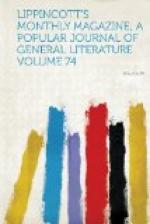After Fanny Lear came Froufrou, the lineal successor of The Stranger as the current masterpiece of the lachrymatory drama. Nothing so tear-compelling as the final act of Froufrou had been seen on the stage for half a century or more. The death of Froufrou was a watery sight, and for any chance to weep we are many of us grateful. And yet it was a German, born in the land of Charlotte and Werther,—it was Heine who remarked on the oddity of praising the “dramatic poet who possesses the art of drawing tears—a talent which he has in common with the meanest onion.” It is noteworthy that it was by way of Germany that English tragedy exerted its singular influence on French comedy. Attracted by the homely power of pieces like The Gamester and Jane Shore, Diderot in France and Lessing in Germany attempted the tragedie bourgeoise, but the right of the “tradesmen’s tragedies”—as Goldsmith called them—to exist at all was questioned until Kotzebue’s pathetic power and theatrical skill captured nearly every stage in Europe. In France the bastard offspring of English tragedy and German drama gave birth to an equally illegitimate comedie larmoyante. And so it happens that while comedy in English literature, resulting from the clash of character, is always on the brink of farce, comedy in French literature may be tinged with passion until it almost turns to tragedy. In France the word “comedy” is elastic and covers a multitude of sins: it includes the laughing Boule and the tearful Froufrou: in fact, the French Melpomene is a sort of Jeanne qui pleure et Jeanne qui rit.
So it happens that Froufrou is a comedy. And indeed the first three acts are comedy of a very high order, full of wit and rich in character. I mentioned The Stranger a few lines back, and the contrast of the two plays shows how much lighter and more delicate French art is. The humor to be found in The Stranger is, to say the least, Teutonic; and German humor is like the simple Italian wines: it will not stand export. And in The Stranger there is really no character, no insight into human nature. Misanthropy and Repentance, as Kotzebue called his play (The Stranger was Sheridan’s title for the English translation he revised for his own theatre), are loud-sounding words when we capitalize them, but they do not deceive us now: we see that the play itself is mostly stalking sententiousness, mawkishly overladen with gush. But in Froufrou there is wit of the latest Parisian kind, and there are characters—people whom we might meet and whom we may remember. Brigard, for one, the reprobate old gentleman, living even in his old age in that Bohemia which has Paris for its capital, and dyeing his few locks because he feels himself unworthy to wear gray hair,—Brigard is a portrait from life. The Baron de Cambri is less individual, and I confess I cannot quite stomach




